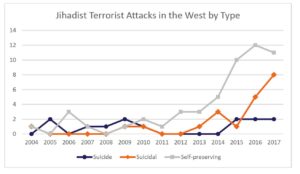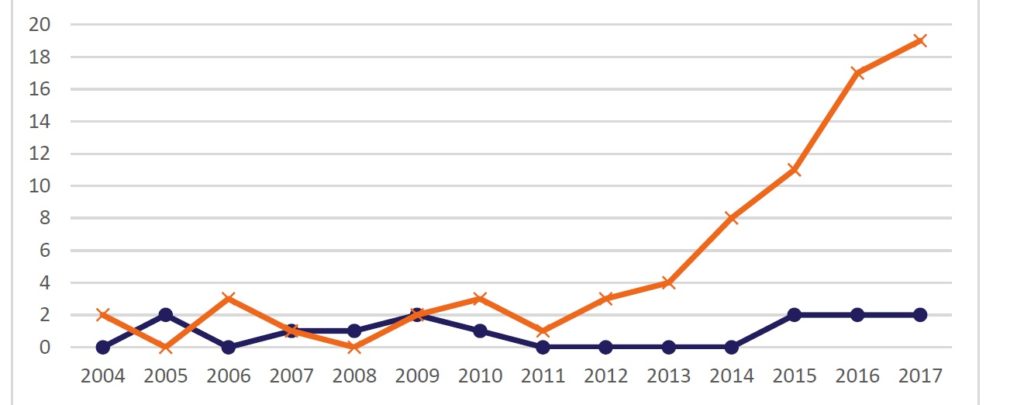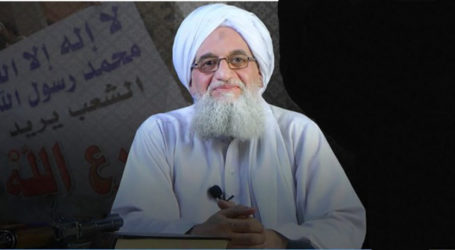Dispositivi escatologici di utilizzo del corpo negli attentati suicidi




 Suicide attacks have long been considered the hallmark of jihadist terrorism, but the truth is that the increase in the number of jihadist terrorist attacks in the West after about 2011 can be accounted for by increases in different types of terrorist attacks. The number of suicide attacks remains fairly constant throughout the time period that has been examined in this report (2004-2017), but there are strong increases in what one could call self-preserving attacks (attacks in which the perpetrator is trying to survive) and suicidal attacks (attacks in which the perpetrator does not kill himself, but rather tries to get police officers or military personnel to kill him). This dual trend towards suicidal and self-preserving attacks might be related to the increase in the number of lone-actor terrorists, who generally have a preference for weapon types that are easier to acquire and use than the IEDs that are typically used in suicide attacks. As suicidal terrorists will attack security forces and self-preserving attackers will try to escape, the operational response to these kinds of attacks should be different from the response to a suicide attack. It is important that protocols and training scenarios are adjusted to reflect the increases in self-preserving and suicidal attacks.
Suicide attacks have long been considered the hallmark of jihadist terrorism, but the truth is that the increase in the number of jihadist terrorist attacks in the West after about 2011 can be accounted for by increases in different types of terrorist attacks. The number of suicide attacks remains fairly constant throughout the time period that has been examined in this report (2004-2017), but there are strong increases in what one could call self-preserving attacks (attacks in which the perpetrator is trying to survive) and suicidal attacks (attacks in which the perpetrator does not kill himself, but rather tries to get police officers or military personnel to kill him). This dual trend towards suicidal and self-preserving attacks might be related to the increase in the number of lone-actor terrorists, who generally have a preference for weapon types that are easier to acquire and use than the IEDs that are typically used in suicide attacks. As suicidal terrorists will attack security forces and self-preserving attackers will try to escape, the operational response to these kinds of attacks should be different from the response to a suicide attack. It is important that protocols and training scenarios are adjusted to reflect the increases in self-preserving and suicidal attacks.
The suicide attack has long been considered the hallmark of jihadist terrorism. Organisations with other ideological goals have committed suicide attacks as well, but many scholars and commentators see jihadists’ willingness to kill themselves in their attacks as a feature that sets jihadist terrorism apart from other forms of terrorism. And indeed, some of the deadliest jihadist attacks in the West in recent years have been suicide bombings. The perpetrators of the attacks in Paris in November 2015 gave their lives to take many more with them, as did the suicide bombers in Brussels (March 2016) and Manchester (May 2017).
But while such attacks understandably attract the most attention and thus influence our perception of the terrorist threat, they make up only one part of the attacks that have been carried out in the West in recent years. In fact, over the last years, the modus operandi of jihadist terrorist attacks in the West has become markedly more diverse, and many of the ‘new’ kinds of attacks are not suicide attacks. For instance, in recent years the vehicle attack has established itself as a modus operandi of choice for Western jihadists. There had been only two vehicle attacks in the West before 2013, a small number compared to the thirteen vehicle attacks in the period of 2013-2017. A similar trend was demonstrated by Nesser and Stenersen regarding attacks with guns and knives. Interestingly, vehicle attacks, stabbings, shootings and other non-suicide attack modes far outnumbered suicide attacks in the West in 2017. There have been 21 jihadist terrorist attacks in the West in the first eleven months of 2017, but only two of these (the Manchester bombing and a vehicle attack with explosives in Paris) were suicide attacks.
1. Case Selection
The first step towards answering the main research question is the compilation of a list of all terrorist attacks in Europe, the United States (US) and Canada in the period from the Madrid bombings to the present.4 The Madrid bombings have been chosen as a starting point because they mark the beginning of the current wave of so-called homegrown jihadist terrorism in the West. In previous attacks, most notably of course the 9/11 attacks, the perpetrators attacked foreign countries. It is true that there were many non-Spaniards and several foreign terrorist organisations involved in the Madrid bombings, but the perpetrators also included a group of Spaniards who were willing to attack their own country.
In order to qualify as a terrorist attack, an incident needs to meet certain criteria. First, only acts of violence have been included in the list; foiled attacks have been left out. Nesser, Stenersen and Oftedal rightly point out that including foiled attacks in an analysis of jihadist modus operandi can be helpful, as it allows us to see whether the completed attacks are actually representative of the operational ambitions of the jihadist movement.6 Certain types of attack may be more vulnerable to detection, and as a result they may be underrepresented among the attacks that have reached the execution stage. On the other hand, the modus operandi of an attack changes constantly during the planning stage, and sometimes even during the attack, so one can only definitively establish a modus operandi after an attack has been carried out. An example that is particularly relevant with regard to the difference between suicide and non-suicide attacks is the attack in the German town of Ansbach in 2016. The perpetrator, Mohammed Daleel, did not have a suicide attack in mind. Initially, he wanted to place the bomb, detonate it from a distance, film the explosion and intimidate the German general public with the footage of the ensuing mayhem. Moreover, he talked to his IS-handlers about carrying out other attacks later on. But after he was refused at the entrance of the music festival he originally wanted to target, he detonated the explosive outside of a nearby wine bar, killing himself and wounding twelve.
Second, for an attack to qualify as an act of terrorist violence, it must have been intended “to have far-reaching psychological repercussions beyond the immediate victim or target.” As terrorism is also a form of political violence, those repercussions are intended to bring about a certain political effect. In the case of jihadist terrorists, such effects could include the withdrawal of Western troops from predominantly Muslim countries or the cessation of the perceived slandering of the prophet Muhammad in cartoons and other forms of satire. Another, but much less common, goal could be putting a stop to the Western way of life in general. Attacks for which there is convincing evidence that the perpetrator(s) intended to send a message to coerce or intimidate governments and/or populations into changing their behaviour in ways that contribute to one of these items on the jihadist political agenda, have been added to the list. Statements of allegiance to jihadist organisations or to individual leaders of such organisations have been considered evidence of a jihadist political motive as well, as has praise to jihad in general. Finally, attacks have been included regardless of whether they had the effect the perpetrators wanted. One could argue that an attack in London carried out by one man with a hammer is unlikely to intimidate the population of the United Kingdom (UK) into withdrawing its support for the government’s foreign policy in the Middle East. At the same time, the perpetrator’s intention may still have been to intimidate for political purposes, and that is what would make this attack an act of terrorism.
Another issue that needs addressing concerns simultaneous attacks. Attacks that have been planned by members of the same cell to be carried out more or less simultaneously, i.e. in a matter of minutes from each other, count as one attack. For instance, the London bombings of 7 July 2005 have been counted as one attack, not as four separate attacks. A series of attacks by the same perpetrator(s), on the other hand, has been counted as separate incidents. For instance, Mohammed Merah’s shootings of 11, 15 and 19 March 2012 have been counted as three separate attacks, not as one drawn-out attack. Some researchers, for instance Hegghammer and Nesser10, have counted Merah’s three attacks as one incident, but there were three days between the first and the second attack and between the second and the third attack. This being the case, Merah’s attacks lacked the element of simultaneity that was present in the 2005 London bombings. Also, it is hard to see how Merah could have been continuously carrying out an attack during these three-day intervals. He was not shooting at or chasing his targets, so his attacks were separated by time periods during which he must have done something else. He may have prepared himself for his attacks in the time between the shootings, but he was not carrying out attacks the entire time. As Merah went back and forth between attacking and doing other things, his attacks have been considered three separate attacks rather than one attack that lasted nine days. The same logic has been applied to similar cases.
2. Suicide and Non-Suicide Attacks in the West
Before we can delve into the data, there is one more definitional question that needs to be addressed, which is of course: what is a suicide attack? There is more than one answer to that question, but narrowly defined a suicide attack is an attack in which the suicide of the perpetrator and the killing of the victims coincide in the sense that they are the result of the same act of violence. For instance, the explosion that kills a suicide bomber is the same explosion that kills the victims. Another example concerns a terrorist who crashes a car into a building. In such cases, the victims and the perpetrator die in the same car crash.
Of all terrorist attacks in the period from March 2004 to November 2017, thirteen qualify as suicide attacks according to this definition. As graph 1 shows, they are divided quite evenly over the entire time period. The last three years stand out for being the only period with two suicide attacks in consecutive years, but there is no year with more than two suicide attacks. (In fairness, though, the last month of 2017 has not been included in the data.)
Jihadists committed eighteen terrorist attacks in the West in the first half of the timeframe, i.e. the period of 2004-2010. Of these eighteen attacks, seven (or 39%) were suicide attacks. Five of these seven attacks were suicide bombings, and they were all unsuccessful, with the exception of the bombings of 7 July 2005 in London. A very similar attack two weeks later failed, as the explosives of four perpetrators failed to detonate. Suicide bombers in Exeter (2008), Milan (2009) and Stockholm (2010) failed as well. The best-known non-suicide attacks in the period of 2004-2010 are probably the Van Gogh murder (2004) and the Fort Hood shooting (2009).
The picture that emerges from the period of 2011-2017 is quite different. There is little change in the total number of suicide attacks: six attacks in this timeframe were suicide attacks. What did change is the casualty rate: the suicide bombings in Manchester (2017), Brussels (2016) and Paris (2015) are among the deadliest terrorist attacks on European soil ever. Interestingly, though, they account for a much smaller part of the overall number of jihadist attacks than the suicide attacks in the first timeframe. There have been 69 terrorist attacks in the West in the period of 2011-2017, so the six suicide attacks in this period represent only about 9% of the whole set of attacks, a decrease of 30%. Again, the difference in absolute numbers is insignificant and the number of victims has increased markedly, but the suicide attacks are clearly outnumbered by the non-suicide attacks.
3. Suicide, Suicidal and Self-Preserving Attacks
At first glance, an increase in the number of non-suicide attacks might suggest that, in recent years, there
previously. But is it really that simple? What if we were to consider the perpetrators who do not commit suicide attacks but who still want to die during their attacks? Nidal Hasan, for instance, did not commit a suicide attack in the narrow sense of the term, but he had no intention of surviving the shooting spree he started in November 2009 at the US Army base in Fort Hood, where he worked as a psychiatrist. During the attack, Hasan was shot five times by a soldier who came to the rescue of his colleagues. He was paralysed from the waist down, but he survived. Nevertheless, his attack was in all likelihood a suicide mission. In the months preceding the attack, Hasan had kept up an e-mail correspondence with radical preacher Anwar al-Awlaki. In one of his e-mails, Hasan argued the legitimacy of suicide attacks in the name of Allah, while in another he wrote that he was looking forward to joining Al-Awlaki in the afterlife. More recently, seventeen-year-old Riaz Khan Ahmadzai attacked passengers on a train in Germany with a knife, then jumped out of the train and attacked a passer-by before he was killed during an assault on a group of police officers. In a letter found shortly after the attack, he asked the addressee, presumably his father, to “pray for me that I can get revenge on these non-believers, pray for me that I go to heaven.”
Hasan and Ahmadzai did not commit suicide attacks, but rather something that could be called suicidal attacks. They did not kill themselves, but they behaved in such a way that the security forces had no choice but to shoot them. Evidently, police shootings do not always result in fatalities, but the two jihadists had wanted this to happen in their cases. In other words, Hasan and Ahmadzai tried to commit the jihadi version of ‘suicide by cop’ (or ‘suicide by police’), a term used for incidents “in which a suicidal individual intentionally engages in life-threatening and criminal behavior with a lethal weapon or what appears to be a lethal weapon toward law enforcement officers or civilians to specifically provoke officers to shoot the suicidal individual in self-defense or to protect civilians.”
With this kind of attack behaviour, perpetrators of suicidal attacks pose very different operational challenges than perpetrators who want to survive: the former will seek a confrontation with the security forces, whereas the latter are likely to attempt an escape. Given the importance of these operational differences for counter-terrorism, it is important to know to what extent the increase in non-suicide attacks can be accounted for by suicidal attacks. This, of course, begs yet another methodological question: how does one recognise a suicidal attack?
Ideally, one would have evidence that the perpetrators said they wanted to die during the attack. Hasan and Ahmadzai expressed their desire to die as martyrs quite explicitly, so it is fairly certain that their attacks were suicidal attacks. Unfortunately, however, only nine non-suicide terrorists on the list left clear evidence about their intentions in this regard. For the other 65 non-suicide attacks, there was no other option but to deduce the intentions of the perpetrators from their behaviour during the attack.
The first way to do this is to take into account the operational environment in which the attack took place. There are operational environments in which a terrorist could reasonably expect to be neutralised by security forces when openly carrying out a terrorist attack. When committing an attack in such an environment, the terrorist willingly and knowingly puts himself in a situation where he is clearly outnumbered and outgunned. While there may be no direct evidence of an ambition to die as a martyr, the fact that a perpetrator goes on the attack in such a setting strongly suggests he is looking to get himself killed. By creating a crisis situation and making himself a target for trained and armed security forces, the terrorist is essentially forcing these security forces to eliminate him. At the very least, a terrorist who behaves this way shows such a strong disregard for his own physical well-being that his behaviour could legitimately be labelled ‘suicidal’.
Another way to recognise suicidal attacks is the absence of evidence that the perpetrator wanted to survive the attack. There have been quite a few cases (40 out of 87, or 46%) in which the perpetrator tried to escape after having committed the attack, which shows that the attack was not suicidal.20 Two other terrorists surrendered to the authorities after having committed an attack, which also suggests that they were not committing suicide attacks. Of course, a lack of evidence that a perpetrator wanted to survive his terrorist attack does not automatically make the attack suicidal, but the reverse is certainly true: a terrorist who tries to escape or who turns himself in is not engaged in a suicidal attack.
In order to get a more detailed view of the changes in the modus operandi of Western jihadists, all 87 jihadist attacks on the list have been labelled as either a suicide attack (perpetrator(s) killed themselves), a suicidal attack (perpetrator(s) wanted to get killed by security forces) or a self-preserving attack (perpetrator(s) wanted to survive). It is true that this categorisation is not unassailable. Suicide attacks are relatively easy to recognise, but it is sometimes hard to tell whether an attack is suicidal or self-preserving. Other researchers or analysts would perhaps classify some attacks on the list differently than the current author. Also, the numbers of attacks per year are still rather small, so the graphs and descriptive statistics presented below should be read with some caution.
That said, the introduction of the category ‘suicidal attack’ does provide ground for some nuance regarding the intentions of the perpetrators of jihadist attacks. Most non-suicide attackers wanted to survive their attack, but a substantial number of them wanted to get killed.
4. Analysis
Returning to the claim that has been made in the introduction, we can observe that there has been a shift in the jihadist modus operandi and that the suicide attack has become rarer in relative terms as a result of increases in the numbers of suicidal and self-preserving attacks. In a flagrant contradiction to the jihadists’ boastful claims that they love death as much as we love life, the self-preserving attack is currently the most frequent kind of jihadist terrorist attack in the West. However, at the same time, the number of suicidal attacks has increased as well, and may at some point exceed the number of self-preserving attacks. There have been eleven self-preserving attacks in the first eleven months of 2017, against eight suicidal attacks. While this is not enough to speak of a new pattern, the number of suicidal attacks went from one in 2015 to five in 2016 and then to eight in 2017, so it would be interesting to see whether this increase will continue in the coming years.
But how do we explain this dual shift towards suicidal and self-preserving attacks? Hard evidence for any explanation would be hard to come by, because even if the perpetrators themselves have a clear idea about why they chose one attack mode over the other two, they are rarely available for comment. However, there is another trend that offers a clue as to how the move towards non-suicide attacks (i.e. self-preserving and suicidal attacks) could be understood.
But how can two contradictory trends (an increasing number of perpetrators who want to escape and an increasing number of perpetrators who want to get killed), be related to the same phenomenon? The key to squaring this circle might be feasibility. It is still hard to tell whether this is in fact part of the reason why lone-actor terrorists tend to refrain from committing suicide attacks, but the data do suggest that they generally have a preference for weapon types that are easier to acquire and use than the IEDs that are typically used (twelve out of thirteen times) in suicide attacks. Of the 66 terrorists who attacked alone, nine (14%) used IEDs, compared to twelve out of the twenty collectives in the dataset (60%).
Admittedly, the fact that a terrorist carries out his attack alone does not automatically mean he has no one around to help him. Mohammed Bouyeri, the murderer of the Dutch Islam-critic Theo van Gogh, and Anis Amri, who committed a vehicle attack on a German Christmas market in 2016, had no help in the execution of their attacks, but they were certainly known in radical circles. Other lone-actor terrorists were instructed through social media by Islamic State members in Syria26, and yet others even attended terrorist training camps. These examples fit the larger pattern observed in a study by Gill, Horgan and Deckert, who found that many lone-actor terrorists are in touch with larger – and sometimes violent – social movements with similar political goals. But while there are ways for lone-actor terrorists to draw on the resources and expertise of other jihadists, working alone does come with certain operational limitations. Especially for lone operatives who choose to do their reconnaissance, weapons acquisition and other material preparations alone as well, as many of them do, it may be tempting not to engage in labour-intensive, risky and complex activities like fabricating explosives. Simpler attack modes, like vehicle, gun and knife attacks, may lend themselves more to attacks by one person, which may partially explain the patterns observed in the previous paragraphs. Terrorists who attack alone may commit fewer suicide attacks since that attack mode requires them to make IEDs, so when attacks by lone operatives become more frequent, the numbers of suicidal and self-preserving attacks will go up, too.
Like all phenomena with any degree of complexity, the increase in the numbers of suicidal and self-preserving attacks is unlikely to be mono-causal. Rather, it is the effect of an interplay of factors, so in looking for an explanation we cannot stop at the number of lone-actor terrorists. One should also, for instance, consider the ‘strategy of a thousand cuts’, propagated prominently by Al-Qaeda’s Yemeni branch (AQAP). In November 2010, the group’s jihad glossy Inspire called on its followers to carry out small, simple attacks, calculating that a large number of small attacks would in the long-term have the same effect as a smaller number of large attacks. The weapons they suggested, like knives and vehicles, do not automatically kill the perpetrators as well, so jihadists taking this advice are likely to commit suicidal or self-preserving attacks.
At the time, AQAP’s call for small, independently organised attacks was considered a way for Al-Qaeda to adjust to the reality that they were an idea rather than an organisation, but the ‘strategy of a thousand cuts’ has since been adopted by the Islamic State as well. The latter group’s commitment to carrying out larger attacks is obvious, but it has also called on its supporters not to come to Syria and prepare attacks in their home countries instead, saying: “The smallest action you do in their heartland is better and more enduring to us than what you would do if you were with us [in Syria and Iraq].” Also, by celebrating jihadists like Mohammed Merah in their propaganda, the group is actively setting an example of a terrorist who committed small attacks.33 Through their skilful use of propaganda through social media, the Islamic State is able to mobilise potential terrorists it never had any face-to-face contact with. For many of these inexperienced and untrained recruits, suicidal and self-preserving attacks are more feasible options, which may explain the increase in these two types of attacks after the Islamic State began to eclipse Al-Qaeda as the world’s most notorious jihadist organisation.
Another factor with some explanatory value vis-à-vis the trend outlined in the previous section may be the tightening of security measures, mentioned by Nesser and Stenersen as one of the possible explanations for the increase in the use of knives and firearms. In their discussion of this factor, they refer to the example of Mohammed Merah, who asked his terrorist trainers in Waziristan to train him in the use of firearms, as he feared that the fabrication of explosives would only get him arrested.34 In a similar vein, Hamm and Spaaij observed that post-9/11 lone-actor terrorists (not just jihadists) in the US rarely commit IED-attacks because the strict regulations on bomb making materials increase the likelihood of an arrest during the preparatory phase of an IED-attack. Stronger evidence is clearly needed before one can confidently make this claim, but we should at least entertain the possibility that the operational environment in the West has become less permissive with regard to the preparation and execution of terrorist attacks with IEDs. According to this logic, the result of the security measures has been that the increase in the overall numbers of attacks is largely an increase of the number attacks with weapons that do not allow the perpetrators to kill themselves and their victims at the same time. (It should be noted that this explanation can easily go together with the previous ones. After all, stricter security measures may well have been one of the factors that led AQAP to adopt the ‘strategy of a thousand cuts’ and could be one of the aspects that make preparing IED-attacks risky to lone-actor terrorists.)
Finally, we might also consider the contagion effect. It has long been established that terrorists exhibit copycat behaviour, and it is hardly a coincidence that the number of vehicle attacks in Europe went up dramatically after the vehicle attack that killed scores of innocent people celebrating the 14th of July on the boulevard in Nice in 2016. Examples of deadly suicidal and self-preserving attacks are now widely available and show that carrying out a terrorist attack does not need much resources and expertise, so it shouldn’t be surprising that there are people who follow that lead.
However, the link between lone-actor terrorists and simple attacks (which self-preserving and suicidal attacks often are) is not uncontested in the literature on lone-actor terrorism. Simon, for instance, states that lone-actor terrorists are more creative in devising attack plans, as they have no need to meet any demands imposed on them by the leadership of organisation. Gill, on the other hand, has a decidedly lower opinion of the operational capabilities of lone-actor terrorists, and the findings of the current study suggest that he is closer to the mark, at least when it comes to jihadist terrorists in the West. If it is true that jihadist terrorists who act alone choose self-preserving and suicidal attacks because there is little else they can do, the creativity that Simon refers to is largely absent in the dataset that has been examined for the current study.
5. Implications
The dual trend towards more suicidal and self-preserving attacks has some important implications, not least with regard to the way the security forces should prepare for terrorist attacks. After all, security forces relate in a different way to the perpetrators of each of the three attack modes. Broadly speaking, the suicide terrorist will try to conceal his attack from the security forces, the suicidal terrorist will attack the security forces and the self-preserving terrorist will try to escape from the security forces. The main difference between the current period and the period of the ‘classic’ suicide attack is therefore that it is now much more likely that there is a perpetrator to be apprehended or neutralised during or after a terrorist attack.
This means, first, that terrorist manhunts are becoming more likely. The aftermath of the Boston bombings in 2013 was an extreme example in terms of the manpower and the impact on the city, which practically went into lockdown, but it was in its essence not exceptional. As the manhunts for the perpetrators of the recent vehicle attacks in Berlin and Barcelona make clear, identifying, tracking down and arresting fugitive terrorists is becoming a more important aspect of the police response to a terrorist attack. Unfortunately, the first police officers who confront terrorists on the run are not always specifically trained and equipped to deal with volatile and sometimes heavily-armed terrorists. This means that either they have to be trained and equipped to confront violent and armed suspects, or – and this is probably the cheaper and less far-reaching option – they need to have and follow strict protocols about when and how to contact special operations units and about what to do in the meantime. But whoever is assigned the task of confronting and neutralising the terrorist, training matters. In the words of one officer who had to arrest the perpetrators of the terrorist attacks in San Bernardino in December 2015: “Regional and realistic training was invaluable. Training came into play tenfold. We didn’t have to think about how we should do it—we just did it.”
Moreover, as the search for a fugitive terrorist is likely to involve many police and possibly military units, unity of command and interoperability are of the essence. Much hinges on coordination and information sharing, sometimes even between different countries, so the search for a terrorist will be much more efficient if there is clarity regarding the chain of command and the platforms and channels to share and receive information. Stovepiping should be avoided at all times, which means that it is crucial that protocols and training scenarios are adjusted accordingly. The chaos that reportedly ensued after Anis Amri’s attack on the Christmas market in Berlin in December 2016 is a painful illustration of what happens if the police do not have the right arrangements in place.
As for the suicidal attack, it is important to note that this attack mode requires security forces to engage in armed confrontations in which they do not have the initiative. They will have to put an end to ongoing attacks in which they themselves might well be the targets. Thus, responding to suicidal attacks requires combat skills as well as a quick assessment of the situation and swift decision-making. With regard to the latter points, it is important to realise that suicidal attacks are rarely protracted affairs. The attack that began on the London Bridge in June 2017 was over in all but eight minutes, while the attack on police officers at Orly airport in March 2017 clocked in at less than three minutes. In such attacks, too, training could be of great help. The perpetrators of suicidal attacks are generally not heavily armed, so while they can do a lot of damage, neutralising them should not be beyond the capacities of security forces who are trained and prepared.
With the collapse of the Islamic State’s caliphate, the possible return of large numbers of foreign fighters from Syria and Iraq, it remains to be seen for how long the jihadist modus operandi will follow the trends outlined in this Research Paper. The terrorist threat, so the cliché goes, is constantly changing, which means that effective counter-terrorism requires constant monitoring, updating of insights and challenging of assumptions. However, as far as is known to the author, there are still few scholarly attempts to do this specifically with regard to the jihadist modus operandi. As the current study is intended to show, a systematic analysis of the way jihadist attacks have been carried out can be helpful in identifying the kinds of attacks we need to be prepared for. The research presented in the previous sections is only a modest attempt, and much more research into the jihadist modus operandi is needed. If we manage to understand which attack mode the jihadists are likely to choose and why, we are one step closer to an adequate preparation.
On a more conceptual level, the findings of the current study raise questions about what it is that jihadists hope to achieve by committing terrorist attacks the way they do. It has been suggested above that factors like feasibility and an unwillingness to risk arrest account for the increase in self-preserving and suicidal attacks, and the current study is not alone in making this point. Schuurman et al., for instance, have stated that “lone actor extremists may match intention to capability rather than the other way around.”If this is indeed the case, one might question the extent to which jihadist terrorism is a rational endeavour aimed at the realisation of political goals. On the one hand, choosing attack modes because they are feasible could be perceived as very rational; jihadists simply choose the easiest and least risky way to go about committing a terrorist attack. However, at the same time, by choosing the most feasible option, many perpetrators of self-preserving and suicidal attacks sacrifice the impact of their attacks to the point where it is virtually absent. There are exceptions, but many self-preserving and suicidal attacks on the list in Appendix I are so small and rudimentary that it is unlikely that many in the general public will even have heard about them. Thus, such attacks contribute little to the realisation of the jihadists’ political goals or even to the stoking of fear among the public.
This can mean two things that are not mutually exclusive. The perpetrators of self-preserving and suicidal attacks have higher hopes of the casualty rate of their actions, or they commit their attacks for reasons other than the attainment of their political goals. As Max Abrahms has argued with regard to more organised forms of terrorism, perpetrators of terrorist attacks do not always engage in terrorism because they want to bring about some kind of political change. The same could go for terrorists who choose attack modes that are feasible but lack impact: perhaps the idea that they will have fulfilled a duty or will have demonstrated a commitment to their principles is more important than making a meaningful contribution to their cause. In other words, such attacks may be more about what Richard English calls “inherent awards to struggle as such.” Obviously, we need to learn much more about the link between intention and modus operandi, and here, too, the current study can only scratch the surface. That said, we should not rule out the possibility that analyses of modus operandi can do more than help us in planning an operational response; the notion that modus operandi also offers a glimpse in the mind of a terrorist might be a starting point for the development of policies in the preventive sphere.





